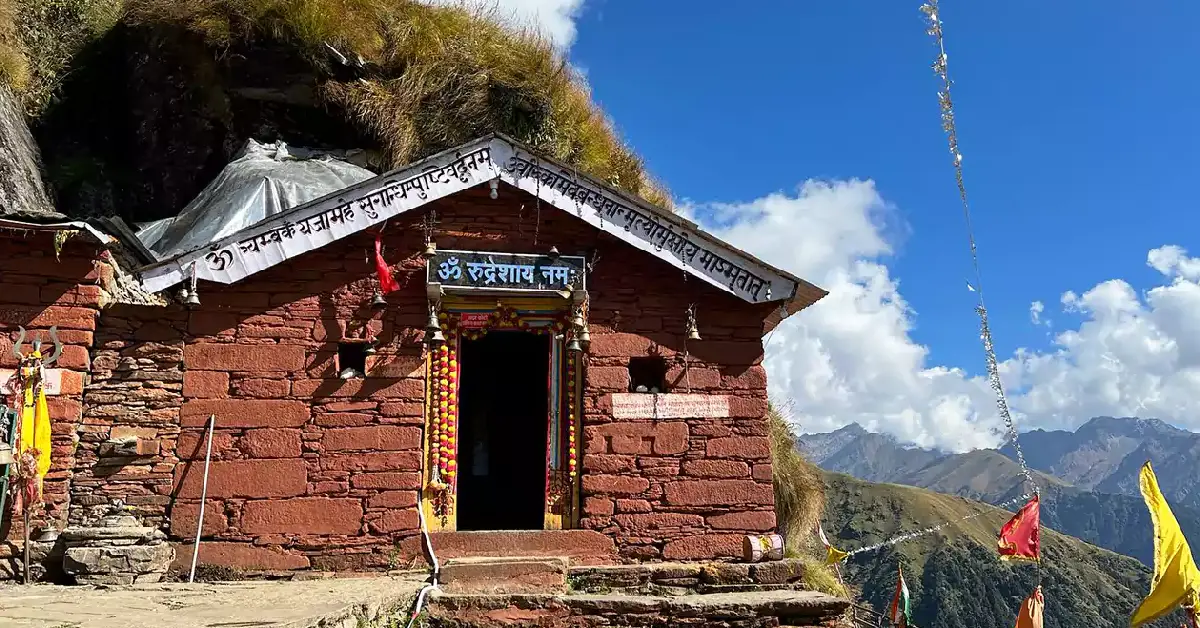Rudranath Temple, one of the revered shrines in the Panch Kedar pilgrimage circuit, is situated in the Garhwal Himalayan region of Uttarakhand, India. At an altitude of approximately 3,600 meters (11,800 feet), this temple is dedicated to Lord Shiva and is believed to be where his face appeared after he transformed into a bull to evade the Pandavas. The temple’s history, architecture, and the myths surrounding it contribute to its significance as a spiritual destination.
Historical Significance
The Rudranath Temple is thought to have been established in the 8th century AD, attributed to Adi Shankaracharya, a prominent philosopher and theologian who played a crucial role in reviving Hinduism in India. The temple’s construction reflects the architectural style of that era and showcases the devotion of early Hindus towards Lord Shiva14.
Mythological Background
The temple’s lore is deeply intertwined with the epic Mahabharata. After the Kurukshetra war, the Pandavas sought forgiveness from Lord Shiva for their sins. To avoid them, Shiva disguised himself as a bull and buried himself underground. His body parts manifested at different locations: his hump at Kedarnath, arms at Tungnath, navel at Madhyamaheshwar, face at Rudranath, and hair at Kalpeshwar. This legend forms the basis for the temple’s importance within the Panch Kedar circuit
Architectural Features
Rudranath Temple is characterized by its natural rock formation that resembles a human face, symbolizing Lord Shiva. This self-manifested (Swyam Bhuva) Shivalinga stands about three feet tall and is adorned with a white cloth tied around its crown. The serene expression on the face and its benevolent gaze are central to the worship practices at this site24.The temple is surrounded by several sacred water bodies like Surya Kund, Chandra Kund, Tara Kund, and Manas Kund, enhancing its spiritual ambiance. The backdrop of majestic peaks such as Nanda Devi and Trishul adds to its picturesque setting
Pilgrimage and Accessibility
Trekking Journey
Reaching Rudranath Temple involves a challenging trek that begins from various points such as Gopeshwar or Urgam Valley. The trek spans several days through dense forests of rhododendrons and alpine meadows, offering breathtaking views of the Himalayas. This adventure not only tests physical endurance but also provides spiritual fulfillment as pilgrims connect with nature while seeking divine blessings
Seasonal Accessibility
The best time to visit Rudranath Temple is between May and October when the weather is favorable for trekking. During winter months, heavy snowfall renders the region inaccessible, leading to the temple’s closure. A ceremonial procession marks the reopening of the temple in spring when devotees welcome back the symbolic image of Shiva from Gopeshwar
Festivals and Rituals
Rudranath Temple hosts various fairs and festivals throughout the year. One notable event occurs on Rakshabandhan when a significant fair attracts numerous pilgrims. During winter months, special rituals are conducted in Gopeshwar as devotees worship a symbolic image of Shiva before it is brought back to Rudranath
Eco-Tourism and Community Involvement
In recent years, there has been an increasing focus on eco-tourism in the region surrounding Rudranath Temple. Efforts are being made to preserve the fragile ecosystem while promoting sustainable tourism practices. Local communities are actively involved in tourism-related activities, helping sustain their cultural heritage while benefiting economically from visitors45.
FAQs about Rudranath Temple
1. What is Rudranath Temple known for?
Rudranath Temple is known for being one of the five sacred shrines in the Panch Kedar circuit dedicated to Lord Shiva. It is particularly revered for its unique natural rock formation resembling Shiva’s face.
How do I reach Rudranath Temple?
The temple can be reached by trekking from Gopeshwar or Urgam Valley. The trek typically takes several days and involves navigating through challenging mountainous terrain.
3. When is the best time to visit?
The ideal time to visit Rudranath Temple is from May to October when weather conditions are suitable for trekking.
4. Are there any festivals celebrated at Rudranath?
Yes, various festivals are celebrated at Rudranath Temple, including a significant fair on Rakshabandhan and rituals during winter months involving a symbolic image of Shiva.
5. Is there accommodation available near Rudranath?
While accommodation options near Rudranath are limited due to its remote location, basic lodges and camps are available along the trekking routes.
Conclusion
Rudranath Temple stands as a testament to India’s rich spiritual heritage and natural beauty. Its historical significance rooted in ancient mythology combined with breathtaking trekking experiences makes it a unique pilgrimage site for devotees and adventure seekers alike. As tourism evolves towards sustainability and community involvement, Rudranath continues to attract those seeking both enlightenment and adventure amidst the majestic Himalayas.




